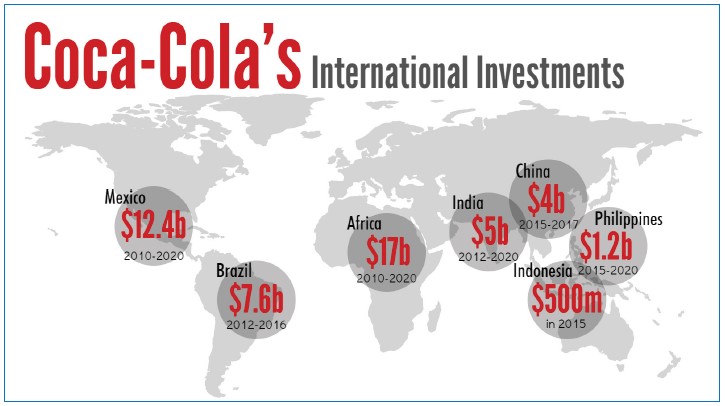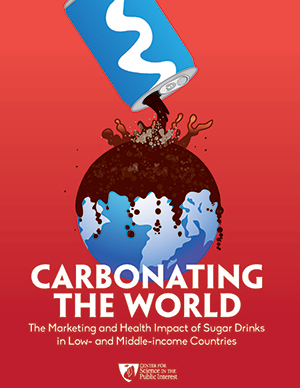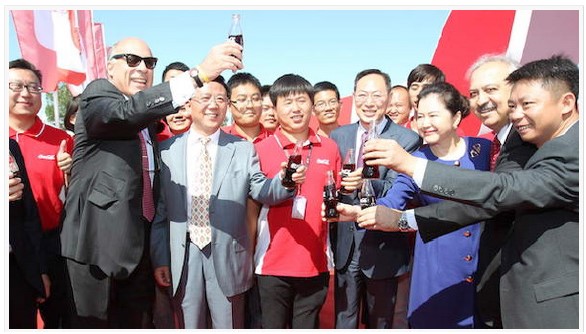Soda companies turning to low- and middle-income countries to replace sagging U.S. soda sales
"Carbonating the world" tracks soda industry in Big Tobacco's global footprints
A report released today by the nonprofit Center for Science in the Public Interest finds that companies are spending billions of dollars a year in such countries as Brazil, China, India, and Mexico to build bottling plants, create distribution networks, and advertise their products. And with that investment, the companies are promoting diabetes, obesity, tooth decay, heart disease, and other soda-related diseases to countries already struggling to provide health care to their growing populations.
The report, Carbonating the World, documents how Coke, Pepsi, and other national and regional soda companies are expanding their reach around the world. In the United States, per-capita consumption of carbonated sugar-sweetened drinks declined by 25 percent between 1998 and 2014, and sales are projected to decline further in North America and in Western Europe. On the other hand, soda sales in Latin America, Asia Pacific, and Middle Eastern and African countries are all projected to increase between now and 2018. Coca-Cola is especially targeting young people, with chief financial officer Gary Fayard calling the world’s 3.5 billion people in their teens and twenties “our core demographic.”

In Mexico, per-capita consumption of carbonated soft drinks is among the highest in the world, at 135 liters in 2013. And Mexico also ranks near the top in the world in adult obesity, first in type 2 diabetes, and fourth in childhood obesity. Between 1999 and 2006, the consumption of calories from soft drinks doubled in some age groups and tripled in others. The local Coca-Cola bottler, Coca-Cola FEMSA, doubled its revenue between 2008 and 2013. Coca-Cola plans to invest $8.2 billion in Mexico between 2014 and 2020, while PepsiCo, which also makes snack foods and cereals, plans to invest $5 billion over five years.
In China, sales of carbonated drinks are expected to grow to $16.2 billion by 2018, which would be an increase of 30 percent since 2013. “It’s our third-largest global market, growing at double digits,” Coca-Cola CEO Muhtar Kent said in 2011. From 2009 to 2011, Coke invested $3 billion in China and said it would invest another $4 billion between 2015 and 2017. PepsiCo, which has 27 percent of the carbonated soft drinks market to Coke’s 58 percent, invested $2.5 billion over a recent three-year period.
The soft drink industry in India is a $10-billion-a-year business and is growing at about six to seven percent annually. Thums Up, a local brand purchased by Coke, is India’s number-one soft drink. While 51 million Indians already suffer from diabetes, the country’s Diabetic Foundation fears that that number will rise to 80 million by 2025.
Coca-Cola is Africa’s biggest employer, with 65,000 employees and 160 plants, and the company planned a $17 billion investment between 2010 and 2020 on that continent. In South Africa, consumption of sugar-sweetened beverages begins early. One study found that such drinks were the third-most commonly consumed food or drink among urban children aged 12 to 24 months. “We have young generations who can consume any kind of food and beverage, [they’re] not caring about their health yet,” Ahmed Nazmy, head of marketing for Coke’s Egyptian franchise, told Advertising Age.
Coke and Pepsi have made public pledges not to market to children, but the pledges are riddled with loopholes, says the CSPI report. Both companies are clearly targeting children, as well as adolescents, using cartoon characters, celebrities, music tie-ins, social media, and prizes to reach them, reported CSPI. The Brazilian sugar-drink brand Dafruta uses the character Barbie to appeal to young girls. CSPI’s report shows Coca-Cola signage on school entrances in South Africa and Ghana. In India, Coke sponsors the Coca-Cola Cup, a cricket tournament for kids aged 12 to 16, and Bollywood star Akshay Kumar promotes Thums Up. Pepsi rewards purchases with free telephone airtime in Nicaragua and uses young celebrities Daniel Padilla and Kathryn Bernardo to reach young Filipinos. “When cigarette sales sagged in the United States and in other countries with robust tobacco control programs, the industry quickly pivoted to the developing world to maintain its profits,” said CSPI president Michael F. Jacobson, co-author of Carbonating the World. “The soda industry is finding that the same strategies work to sell soda. These are countries with growing populations, growing incomes, and with governments less likely to pursue aggressive strategies to deter consumption.”
CSPI’s report recommends that governments around the world make improved nutrition a priority, and take such actions as restricting the sugar content of beverages and levying excise taxes on sugar drinks, with the revenues used to sponsor health and nutrition programs. Mexico has taken the lead on soda taxes, with a tax first levied in 2014 that reduced sales of soda by at least six percent.
Governments, says CSPI, should also require warning labels on sugar-drink containers and protect kids by barring soda sales in schools and advertising in child-directed media. Ecuador and Chile have required easy-to-read nutrition labels for foods high in added sugars.
The report also recommends that the World Health Organization provide technical assistance to national health officials to help them strengthen policies that discourage soda consumption. In its recent report Ending Childhood Obesity, the World Health Organization called for adopting sugar taxes and ending the marketing of sugary drinks to children.
“Despite Big Soda’s enormous power, sugar drinks are increasingly being removed from schools and public spaces, bold nutrition labels are being placed on products, taxes are being levied, and marketing is being regulated,” said Alejandro Calvillo Unna, executive director of El Poder del Consumidor, the Mexican consumer group that led that country’s successful campaign for a tax. “These pioneering policies are crucial to our societies but must be strengthened and multiplied, in the face of heavy industry pushback. And most importantly, despite multi-million-dollar marketing campaigns, more and more consumers no longer associate these drinks with happiness, but with disease.”
Carbonating the World: The Marketing and Health Impact of Sugar Drinks in Low- and Middle-income Countries was written by Allyn L. Taylor, an expert in global health law at the University of Washington School of Law, and CSPI’s Jacobson. Spanish and Portuguese translations of the executive summary are also available.



